41 Geckos Enrichment Ideas and Toys (They are Fun!)
Many newbie gecko keepers and breeders have the misconception that enrichment is an expensive and complicated process. However, this is not necessarily true. You can successfully provide entertainment and play for your gecko using a variety of cheap items and activities that don’t require any money!
In general, keepers and breeders can entertain and engage their geckos with various forms of enrichment. This may be as simple as presenting multiple options to meet their physiological needs (food, security, heat, etc.). Enrichment may also be costly (fully bioactive tank) or difficult to accomplish (training).
What makes an object or task enriching for our scaly babies? Is the entertainment value alone enough to make something an enrichment? Learn more about the science behind enrichment!
1. Various Insects
The simplest and easiest way to provide a gecko with enrichment is by offering it a variety of insects to feed on. Besides enrichment, this also gives pet geckos a more balanced diet for both insectivores (insect-eaters) and frugivores (insect-and-fruit-eater).
If you’re a newbie pet parent, your baby gecko most likely has a diet consisting of two to three of the most common live feeder insects. You might not even have access to live feeders, so you may be forced to give them freeze-dried and canned feeders.
But think about it, if you could only eat two or three dishes—without the option to choose, might I add—you’ll probably get tired of their taste in just a matter of days. You won’t get the complete nutrition you need either!
Make sure that your geckos are offered a variety of feeder insects from reliable providers and resellers to ensure their quality.
Below are 11 common feeder insects given to geckos:
- Roaches
- Locusts
- Grasshoppers
- Crickets
- Silkworms
- Mealworms
- Superworms
- Black soldier fly larvae (BSFL)
- Hornworms
- Butterworms
- Waxworms
Note: The list above is arranged from the most nutritious insects to fatty ‘treat” insects. Those at the top should be offered more frequently. Otherwise, a gecko may become a picky eater.
Since we have complete control over what our precious little geckos can eat, why don’t we give them all there is to offer? Provided that you can get your hands on them of course. Your gecko will no doubt appreciate it!
Which is More Enriching: Meal-Replacement Powders or Feeder Insects?
Meal-replacement powders are arguably more nutritionally complete (depending on their formulation). However, live feeder insects have a lot more enrichment value. Insects, for instance, are more visually stimulating than flavored pastes in a container. As such it’s important to still add insects into the diets of frugivore geckos on powdered mixes.
2. Assorted Fruits
Similar to any other food item, geckos that require fruits in their diet should also be given a wide array to choose from for feeding enrichment. Ideally, these should be available in their native habitats and given to them when in season. Nevertheless, commonly available fruits are also viable options.
The flesh of the following fruits may be incorporated into a frugivore gecko’s diet:
- Apple
- Banana
- Date
- Guava
- Fig
- Mango
- Plum
Find out what other fruits are safe for them in our article on foods gecko can and can’t eat.
If it’s hard to get fresh in-season fruits where you are, you can try sourcing them from neighboring states and then freezing them to preserve them. Other alternatives include unsweetened apple sauce, purees, jellied fruits, baby food, and the like.
However, these latter options are typically a little too sweet for our little geckos. Only offer them sparingly—about once a week.
3. Live Prey
Live prey is the most enriching food for geckos providing them with entertainment in actively exercising their hunting instincts. Insects that crawl, hop, and fly are great for not only feeding enrichment but also sensory and cognitive enrichment among many other categories.
Just to give you a fair bit of warning, though—never dump a buttload of live insects into your pet’s tank! There are many risks in doing that, which include having hard-to-find leftovers.
Remember the following tips when offering live insects to geckos:
- Only give one or a couple at a time
- Place them in different areas of the enclosure
- Ensure that all the bugs are eaten
- Uneaten insects should be removed from the tank
- Change up their feeding schedule once in a while
More importantly, avoid directly feeding geckos using dishes and tongs unless they have mobility issues and other severely limiting conditions. These should be avoided as much as possible to encourage the gecko to stalk and capture its prey more naturally.
Are Live Insects Better Than Dried, Frozen, and Canned Ones?
Though canned and freeze-dried insects are great for emergencies, they have reduced nutritional and enrichment value compared to live feeder insects. Therefore, live insects are the preferred staple food choice for geckos.
For us humans, this may be hard to understand, especially since we no longer really need to hunt for our food. Just a quick trip to the supermarket and we’re all good!
However, we need to remind ourselves constantly that what we think is “best” and “normal” are not always applicable to our reptiles.
4. Feeder Ball
Gecko owners can buy or create feeder balls for enrichment. These are generally hollow balls or egg-shaped containers which can contain both live and dried insects, as well as fruits.
Not immediately offering food items to geckos is a good method to add enrichment to their monotonous lives.
With their food stuck in the ball, they will not only be physically challenged by pushing it around but also mentally challenged in trying to figure out how to get the food! You can buy a feeder ball like the one below, it is quite good.
DIY Feeder Ball
But what if you want to create your own? Well, you will first need a drill, soldering iron, or a heated copper pole, or an old blunt screwdriver. Then, of course, your choice of hollow plastic ball. Some people use golf balls, ping pong balls, and similar-sized spherical toys.
Personally, I prefer using Easter eggs. You could also opt to recycle the plastic containers from those chocolate candies with tiny toys inside.
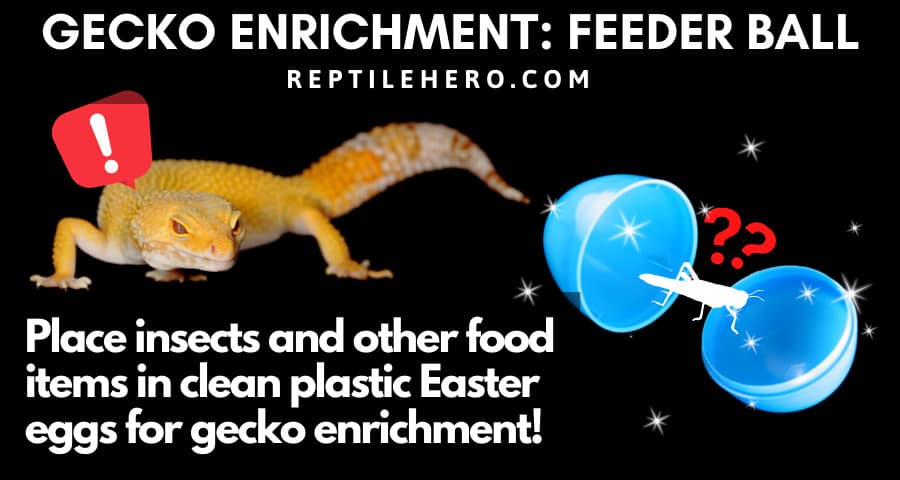
Once you have your materials, just make a few holes into the ball. Make them large enough so that the feeder can go in or out. Finally, fill them with different food items and place them in your gecko’s vivarium.
5. Pill Case
Another good enrichment option related to feeding is to place several different insects into transparent or translucent pill cases. This way, the geckos can investigate all choices and choose which ones to eat first.
This is something I only came across quite recently but I think it’s genius! Compared to the previous method, pill case feeders are much easier to get to for geckos who have difficulty moving around due to a disease or condition (e.g., enigma syndrome).
How can you make one? Just like before, the materials are easy to find and the process is simple.
To create a pill case feeder, you need the following:
- Pill case or any similar container
- Tool to create holes in the plastic
- A good variety of food items
Other containers include ice trays and chocolate molds. What’s important is that 1) the insects placed inside are still visible and 2) there are built-in compartments for each insect.
Create holes on the sides and lids of the case and then place one insect in each compartment. It’s that quick and easy! All you have left to do is to give it to your gecko.
Again, this can be used for fruits and sweet treats—just make sure the hole is big enough for them to reach inside.
6. Insect Dispenser
An insect dispenser, or a slow-release feeder, is a great tool that gives geckos a naturalistic and enriching experience while foraging for food in their enclosure. Typically, these are made to resemble rotting wood which contains a lot of live insects.
Unfortunately, automatic live food dispensers are not a widely available thing. At least, from what I know. There are no readily available products like this so keepers need to create one for their geckos.
The idea for using such a method to feed geckos is to simulate what they would experience in the wild. As mentioned earlier, it’s normal for wild geckos to come across rotting organic material in the wild with lots of bugs hiding within their hollowed-out nooks and crannies.
Here are the materials needed to make a fake rotten log feeder:
- Plastic holding container (e.g., empty water bottle)
- Silicone or reptile-safe adhesives
- Wood or cork bark
- Drill or soldering iron
- Several live insects
Follow these steps to create a manual insect dispenser for geckos:
- Make sure that the container is clean. If not, disinfect it.
- Attach the wood or cork bark to the outside of the container with silicone.
- Let it cure completely.
- Create several holes of varying sizes on the fake log. Ideally, only from the top half so that insects can’t escape too easily and quickly.
- Seal around the holes.
- Let it cure completely, for the second time.
- Put live insects in the container and close its lid. You can do this in batches.
- Lastly, place it in your gecko’s tank.
Your gecko may see the bugs as they try to crawl out of the holes in the dispenser. Or they may only notice an insect once it has successfully come out of the fake wood feeder.
7. Hidden Treats
Position treats deep within plant foliage, or bury them under a thin layer of substrate for an enriching hunting experience. Other less-visited areas and hides in the tank are good hiding places for treats too. This teaches them to associate the activity with rewards.
Treats include fatty insects and what I normally refer to as “sweets”—honeyed water, flower nectar, etc. Unlike most other nutrient-dense food items, these are like junk food. They taste so good, but they can be so bad for our geckos.
So to offset things, we need to make our geckos work harder to get their treats. Have them explore, dig, and climb all over the place to get those yummy treats!
You can think of it like those scavenger hunts people used to throw when we were kids. We had to search around the house to look for candies and chips.
8. Puzzle Feeder
Puzzle feeders are great for cognitive enrichment during feeding time. Using a puzzle feeder, your gecko will have to examine and learn how to secure the food with trial and error.
If you think your geckos are too simple-minded for this, have a little more faith! Geckos are a lot smarter than people give them credit for.
Go to your local pet store or check out online shops. There are many different types and styles of puzzle feeders to choose from.
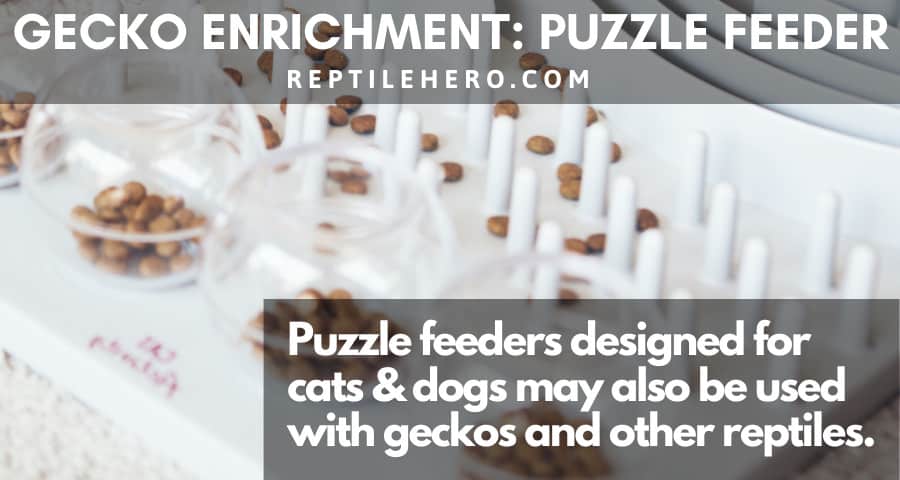
There are complicated puzzle feeders that have moving parts (here on Amazon). Other styles are much less complicated. Granted, they are typically made for our furry pets and not our scaly babies. So they aren’t perfect for our little cold-blooded critters.
Nevertheless, our pet geckos—and reptiles, in general—will still be able to make use of these nifty toys. In fact, with a quick search on the internet, you’re bound to see quite a few videos on this!
9. Foraging Toy
Though they are typically designed for birds, foraging toys can be enriching for both arboreal (tree-dwelling) and terrestrial (ground-dwelling) geckos. Some have several small pockets which can be used to hold different edible and non-edible items for enrichment.
My favorite has got to be the dragon-fruit-like foraging toy as the crazy one below. I love how hassle-free and affordable it is.
Plus, it’s made from organic materials—primarily dried palm leaves. So you won’t have to worry about potential toxins and hazards.
You can hang it from plants and branches in your gecko’s enclosure. Or just leave laying on the ground as it is. But most gecko owners recommend inserting food, treats, flowers, and a bunch of other things in the little recesses all over the toy.
10. Novel Items
Generally, any novel item can give geckos some enrichment. These items include anything from toys to natural materials and even household items. However, these must only be presented to geckos for a limited amount of items for them to retain their novelty.
Again, I would like to emphasize that when it comes to enrichment, you don’t necessarily have to blow your budget. You don’t even have to buy anything new at all. Many gecko pet parents even use recyclable items like the inner core of tissue paper rolls.
Reptile-keepers who also have green thumbs pick leaves, twigs, and flowers from their gardens for their gecko’s enrichment needs.
Got old toys that you won’t be needing anymore? Give it to your geckos! You’ll have fun seeing how they react and play with it. Just make sure that your novel item of choice can’t hurt your gecko.
Do not give a gecko novel items that:
- are too loud
- are too small (e.g., choking hazard)
- have sharp edges
- emit intense light (i.e., laser)
Furthermore, you have to offer several novel items in rotation and for limited periods only so that they stay interesting for your inquisitive gecko.
More importantly, observe your gecko’s response to the novel item. If it reacts negatively (e.g., excessive vocalization, gaping), you may have to remove the item from its enclosure to avoid inducing unnecessary stress.
11. Wheels & Saucers
Experienced gecko owners have also used large hamster wheels and running saucers for enrichment with varying success. Giving lizards these plastic devices can facilitate activity even in relatively small spaces.
One thing you have to really pay attention to when buying something like this, especially a hamster wheel, is the size. Generally, it should be at least 10 inches in diameter so that your gecko won’t be forced to arch its back unnaturally. The one below is pretty neat!
Besides that, see if there are slits on the surface of the product you are eyeing. If there are any, look for something else. Geckos can have their tails and/or limbs caught in those. I’ve seen pretty bloody injuries because of them.
Make sure that your geckos have easy access to these wheels and saucers as well. A stone of two, for example, can act as sort of a stepping stool for geckos to safely get on them.
What About Hamster Balls? Are They Good for Geckos?
Since these are typically used for hamsters and similar pet rodents you might be considering buying those translucent plastic balls too. But I have to stop you right there! The risks of placing geckos in hamster balls far outweigh the potential benefits.
Unlike hamster wheels and running saucers, geckos can’t readily get out of hamster balls when they’ve had enough.
12. Scented Objects
Numerous gecko keepers have also found that objects that naturally have a distinct smell (e.g., plants, prey, etc.) are good options for sensory enrichment. An alternative to this is imparting different scents onto objects.
At first, I was very reluctant to use things like perfume, essential oils, and other fragrant solutions for this. However, many experienced reptile zookeepers say that these can be safe and enriching as long as they are heavily diluted and cannot be licked or ingested by the animal.
There are several materials you can impart scents on for gecko enrichment including, but not limited to, fabric, brick fragments, hides, and so on.
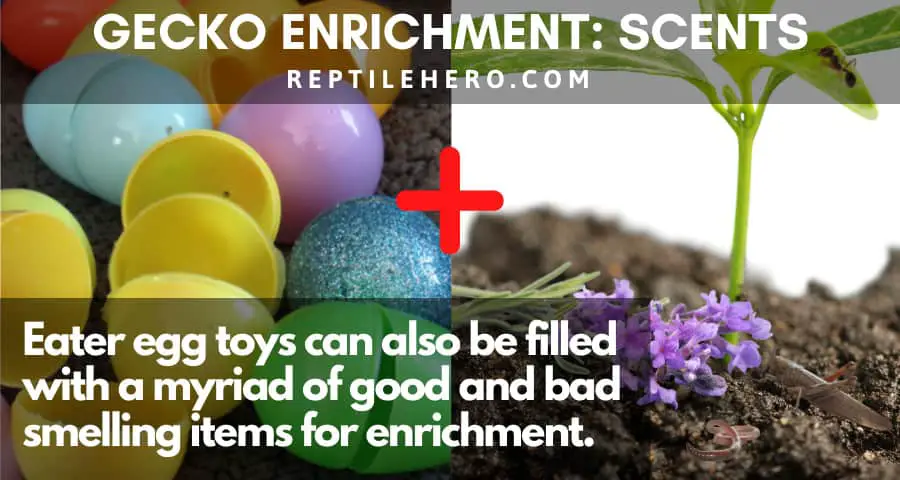
You can also use something similar to feeder balls. But instead of filling them with food items, fill them with different pungent or aromatic materials. Flower, leaves, fruit, and veggie peels or juices are commonly used.
More unique options include smelly shirts, muddy socks, animal shedsd, feathers, and even droppings. To ensure the gecko’s safety, these are typically disinfected or frozen before their presentation.
Others who own multiple geckos sometimes switch around one hide among their pets.
13. Plant Matter
Adding fake and real plant materials can be highly enriching for geckos. These can be permanently incorporated into the tank setup or can easily be replaced and changed like pockets in the background to insert small potted plants.
Many beginner keepers have the misconception that only tropical arboreal species of a gecko will benefit from having plants scattered throughout their enclosures. But even terrestrial species that live in relatively arid areas will find enrichment value with various plant matter.
Plats are great in that they not only add to the aesthetic value of an enclosure but also effectively add enrichment value to a gecko’s home.
Below is a list of commonly used plant materials in gecko tanks and their respective enrichment benefits.
1. Different Plants
Having a good handful of diverse plants adds color, texture, and many other enriching factors to a gecko tank. Just make sure that they are safe and species-appropriate.
See what plants are safe for your gecko in our article on best plants for geckos.
2. Vibrant Flowers
Vibrant flowers can not only be visually appealing but also appealing due to their scent and nectar. Just make sure it isn’t poisonous for geckos!
3. Dense Foliage
Plants with big and/or dense leaves create shadows in reptile tanks. They let geckos inhabiting the enclosure feel more secure while moving around, hence promoting exploration.
4. Leaf Litter
Adding loose leaf litter to the enclosure simulates the foliage-covered grounds in the native habitats of some geckos. However, even arid or desert geckos can have a blast moving these around and burrowing into them.
5. Sturdy Vines
Most geckos will find enjoyment in climbing onto sturdy plants and vines. And yes, that includes many of the terrestrial geckos we are familiar with.
14. Wood & Cork
Tank accessories and furnishings made out of wood and cork are great additions for long-term, in-tank enrichment for geckos. Owners can readily buy or easily create these for their pets’ enclosures.
More often than not, owners of tropical gecko species fill their pet’s tank with word and cork furnishings.
Common wood and/or cork accessories used for enrichment in gecko tanks include:
- Simple or interconnected branches
- Realistic and stylized hides
- Imitation trunks/logs
- Twigs and sticks
- Different-shaped bark for hides or decor
These aren’t made just to fill up the empty spaces in your gecko’s enclosure. However, I do understand where the confusion stems from since these are typically referred to as “clutter” in the reptile-keeping community.
In reality, clutter is put into an enclosure to add interest to the tank—for you and your lovely geckos. Wood and cork furnishings effectively make a tank more dynamic and engaging.
More importantly, it encourages your geckos to actively explore and investigate their surroundings and so much more—hitting multiple different categories of enrichment such as sensory and cognitive.
15. Rocks & Tiles
Rocks and textured tiles provide geckos with tactile environmental enrichment that barren tank setups typically lack.
It’s no easy task to be able to give sufficient enriching objects and activities when a gecko is kept in a considerably bare tank—regardless of whether it is due to health concerns or not.
These stones and tile materials can also be used in temporary quarantine enclosures so that new and sick captive geckos are not completely deprived of enrichment.
You can use them as they are or you can unleash your creativity!
Although I have yet to create any myself, I have seen many other gecko keepers and breeders create fun and practical tank decors with varying sizes of rocks and different tiles of naturalistic tiles—like slate and unglazed clay.
Do be mindful of sharp edges though. Remember to polish those before placing your creation anywhere near your gecko to prevent unwanted incidents which could turn bloody.
16. Multiple Hides
At the very least, each gecko should be provided three separate hides in their enclosures for both security and enrichment. Ideally, however, geckos should be able to choose from multiple different kinds and sizes of hides situated in different parts of their enclosure.
Why is three hides the minimum? This is because at least one hide should be in each thermal gradient region—one cool hide, one middle hide, and one warm hide.

Additionally, make sure to give your gecko at least one moist hide to facilitate successful regular shedding. Otherwise, your gecko will likely often struggle with bad stuck shed.
Lastly, you need to really have the specific needs of your gecko in mind. Think about how they live in the wild. Where do they take shelter? How do they get to their refuge sites?
Hides for Arboreal Geckos
Crested geckos, gargoyle geckos, day geckos, tokay geckos, and many other arboreal geckos prefer hanging around, and I mean that literally. Their wild counterparts normally travel between tall shrubs and trees.
So if you want to replicate what they do in the wild, carefully consider your gecko’s hide placement. You would want an arboreal gecko hide that 1) can be securely hung from the enclosure ceiling or 2) placed on elevated nooks in the tank as the cool one below.
Nonetheless, placing a few additional hides on top of the substrate could give them more options to choose from.
Hides for Terrestrial Geckos
Leopard geckos, fat-tailed geckos, Bibron’s geckos, and many other primarily terrestrial geckos typically prefer staying on the ground or burrowing into it.
So, for the most part, you need to find ways to give them underground shelters and ground-level hides.
Of course, they may also find even more enrichment with a couple of hides placed higher up in their enclosures—but not too close to their heat lamps. Just make sure that they can safely reach these hides.
17. Tunnel Systems
Polyvinyl chloride (PVC) pipes and hamster tunnels can both be used to create highly enriching tunnel systems for gecko tanks. However, these can be quite expensive to build and hard to clean.
Because such tank builds are quite costly and time-consuming to complete, it is considered a rare feature in reptile vivariums, in general.
One would need the following materials to create a tunnel system permanently incorporated into a gecko’s enclosure:
- Large PVC pipes—wide enough for geckos to comfortably navigate through.
- Various PVC fittings—to create a non-linear, more naturalistic tunnel cavities
- Several silicone tubes—to secure the pipes and fittings together
- Copious amount of substrate—to cover up the exposed pipes
- An expansive enclosure—otherwise, you may have trouble fitting everything inside
Needless to say, you might struggle to finish building this in one sitting. Plus, this isn’t exactly the easiest or cheapest way to give you geckos a very enriching tank feature.
A more temporary but also more affordable alternative is to use those large plastic tunnels made for rats and hamsters.
However, the main drawback with those is that they are often quite tight. So not all geckos will be able to fit in them. Worst-case scenario, your gecko could get stuck if you force it to enter the tunnels.
18. Textured Backgrounds
There are several affordable and simple textured backgrounds available on the market which can provide your gecko with tactile enrichment. More expensive options also integrate several other enrichment objects and features into the design, providing holistic enrichment.
A simple textured background or insert is typically made using expanding foam or foam sheets. They are then formed and designed to fit a certain style (e.g., themed, naturalistic) with materials such as silicone, grout, sand, and what have you.
Years ago I saw one naturalistic exhibit where a pair of breeding geckos were inside this massive tank that had a very realistic textured background. Ever since then, I viewed it as the ultimate goal for reptile keepers. The best enclosure we can provide for geckos.
It had a complex tunnel system built into the very back of the background. The cavities of the tunnels were partially exposed, with their openings facing the glass wall. If you’re familiar with ant farms (formicarium), it’s similar to that—letting people observe from the outside.
On the front, it also had various hides and other interesting features. Sadly, not all of us have the time nor the resources to create a grand enrichment background.
But that doesn’t mean we have no other choice. You can also check out shops that create reptile enclosures. They typically offer a few designs of textured backgrounds like this one on Zen Habitats.
Several other experienced keepers also create simpler and smaller enrichment backgrounds and inserts for their geckos using materials like expanding foam and grout. At times, they would rotate multiple themed designs throughout the year.
19. Hammocks & Ledges
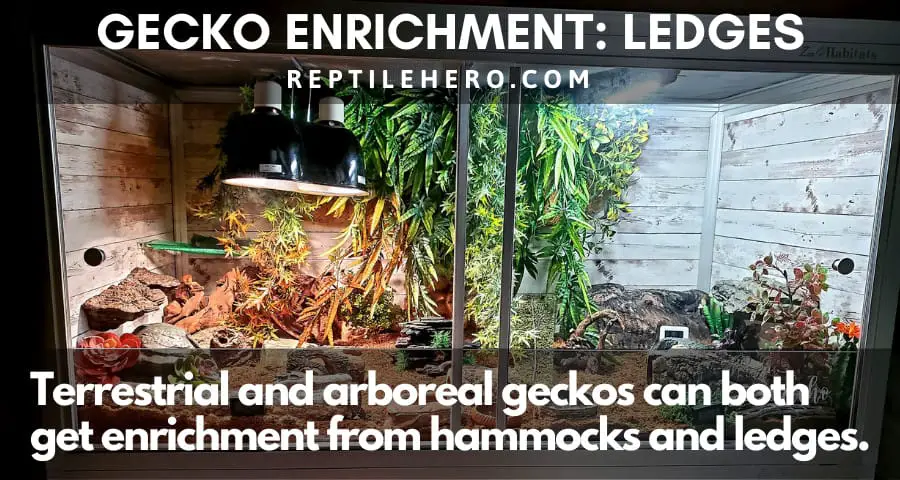
Having hammocks and ledges around the tank walls can also provide geckos with affordable enrichment opportunities. Furthermore, they provide greater usable space for geckos compared to very open vivariums.
From my experience, when keepers say that their geckos never get active enough, it’s simply because they have no other space to explore or the opportunity to do so.
Since most gecko parents are working with a tight budget, it’s almost always impossible to readily be able to give our cute little geckos the tank upgrade they deserve. But don’t worry, the solution to this is actually quite simple.
A good and relatively cheap way to work around a complete enclosure change is to add hammocks and/or ledges to your gecko’s pretty bare tank. You could even connect them using bridges, perches, or suspended tubes—even kitchen towel cores will do!
You can easily find good-quality hammocks from exotic pet stores and online shops. On the other hand, my friends and I have found it harder to find any good and sturdy ledge for our gecko’s vivariums.
Shops that offer customizable tank ledges for reptiles generally offer better products for a higher price tag. But I think those are worth it, considering the possibility that dirt-cheap options could quickly lose their grip on the enclosure walls. Plus, you can always make one yourself!
20. Raised Platforms
Other keepers prefer providing more secure raised platforms for their geckos which are generally anchored into the tank substrate. This is because added elevation doesn’t necessarily have to be completely suspended from the ground for it to have enrichment value for geckos.
To be completely frank, the existence of heavy raised platforms has put me off of the idea of only adding ledges and hammocks to any reptile enclosure.
With a raised platform that’s incorporated into a textured background or laid on top of a hide (here on Zen Habitats), I don’t have to worry about my precious babies falling off even if he is on the bigger side of the scale.
There are no suction cups that have the risk of losing suction with secure raised platforms. Such platforms can effectively hold even the more heavy-set gecko species like leachianus geckos.
Moreover, they provide additional basking areas when placed near the basking spot of gecko tanks. Aside from that, these platforms could give your geckos a great vantage point inside their enclosure and also allows them to effortlessly see outside of their tanks.
21. Several Levels
Experts also recommend adding more expansive additional levels into spacious and tall gecko enclosures to provide geckos with more usable floor space. This, in turn, also increases opportunities for geckos while they are in their enclosures.
Now, if you have the money to spare for a more permanent source of enrichment for your gecko, then this enrichment method is perfect for you!
Actually, I would suggest you consider this first before thinking of all the other greatly enriching furnishings and features I have mentioned so far. By doing so, you can design the best tank for your gecko!
If you’re still a little confused about why having several floors in geckos tanks is a form of enrichment, don’t worry! The answer is pretty simple.
More levels equate to a more workable room. Consequently, a more workable room means more accessories, decors, and furnishings. As a result, your gecko will have more freedom to interact with its environment and actively explore.
To put it simply, several enclosure levels correspond with more enriching objects and enrichment activities.
22. Stairs & Ladders
Including stairs and ladders in a gecko tank’s design will provide it with more enrichment opportunities at varying levels. These provide geckos with a safe way of going up and down high places that could otherwise be inaccessible to them.
Unless you have geckos with naturally sticky toes, you will have to provide your geckos with safe access to the various elevated sections and features in their enclosures.
So to ensure your gecko’s safety whenever it goes around its tank for an adventure—be it vertically or horizontally, have multiple ladders and or stairs.
Got a gecko with special needs and/or mobility issues? Then go for a gradually sloping ramp as the one below.
Even your arboreal geckos will find this useful when they start having difficulty with their sticky toe pads!
Finally, remember to also put plenty of perches and bridges in between these raised features for a gecko to confidently explore its home.
23. Light & Darkness
Ensuring that a pet gecko experiences naturalistic day and night cycles according to the changing seasons, is one of the most efficient forms of climate enrichment. This will stimulate their circadian rhythms and induce natural diel or daily activity patterns.
Do note that this is a very species-specific concern. The native habitat of your gecko will help you determine how much light and darkness they should receive regularly.
For example, some geckos will only need about 10 hours of light during the day in the winter months. That same species could also require roughly 14 hours of daylight in the height of summer.
However, the most basic lighting schedule keepers and breeders follow is the 12-hour light (day) and 12-hour darkness (night).
It’s also crucial for gecko owners to remember that any animal should have access to sufficient shaded refuge sites during the day. So make sure that your gecko’s tank has enough clutter in it.
More importantly, geckos must have ultraviolet-B (UV-B) light for efficient basking—both open and cryptic. This is something they would naturally have access to in the wild as well.
24. Thermal Gradients
To successfully encourage a gecko to perform various natural behaviors, climate enrichment through thermal gradients is necessary. As ectothermic animals, they require deeply penetrating heat to properly carry out a myriad of tasks (e.g., hunting, playing).
If you attentively listened to your biology teacher’s lessons back then, you would know that cold-blooded animals such as geckos need heat to not only survive but also thrive.
Generally, halogen lamps are considered the best heat source for most, if not all, gecko species. This is because they are affordable light-emitting heat lamps that most closely replicate natural sunlight.
Discover which heaters are safe in our article on the best heating set-up for geckos.
But this doesn’t mean that they should have lighting and heating 24/7. Just like lighting, geckos also need their heating on a spectrum. This is commonly called a thermal gradient and it consists of 3 main sections—the warm side, middle, and cool side.
However, the thermal gradients that arboreal geckos need are a bit more complicated since they are typically housed in taller enclosures. So there is an additional, even colder section at the lower half of their tank.
25. Humidity Variations
Another essential form of climate enrichment for geckos, and most other reptiles, is exposure to varying levels of humidity. This can be easily achieved by gecko keepers with the use of tank furnishings and accessories such as humid hides, water dishes, and live plants.
Of the three specific things I mentioned, humid hides and water dishes are basic provisions that should always be available to your geckos. Aside from providing enrichment value, these also help geckos stay hydrated and have successful sheds.
Ideally, the humidity levels in your gecko’s tank should fluctuate throughout the day with the seasons. You just need to make sure that it stays within the optimal range for their species!
1. Humid Hide
Moist or humid hides should regularly be misted so that it retains substantial humidity for your geckos—which, again, will vary depending on their species.
You should also check on it often to change the bedding as soon as it’s soiled. Doing this will also prevent the growth of mold and bacteria.
2. Water Dish
Some keepers only use one water dish, whereas others prefer having two—a small container for drinking and a large shallow one for soaking or bathing.
Additionally, live plants can help provide different levels of humidity. There are also specialized devices that can help simulate more naturalistic climates, boosting and dipping at times. So let’s move on to that!
26. Misting Systems
Misting regularly provides geckos with enrichment. This can be done manually or automatically. Doing so can also help hydrate a gecko and boost humidity within its tank.
I know this sounds like such an exaggeration, but misting gecko tanks really can easily and effectively give our smiley little geckos highly enriching experiences.
Any clean spray bottle you have at home will be enough for manual misting. But people with much larger reptile collections—geckos included, of course—will likely find it much easier to mist all their tanks automatically using rain or sprinkler systems.
Just pick what suits your situation best!
Replicate What Your Gecko Would Experience in the Wild
Geckos native to tropical areas will greatly benefit from the opportunity of experiencing realistic rainfall in the safety of their tanks. Alpine geckos may also find the addition of foggers more enriching.

In contrast, geckos who are originally from more arid countries should be offered this form of enrichment less often and less intensely. Rather than having them rain, let them see what a drizzle is like.
Just keep in mind that water is bound to accumulate at the bottom of your gecko’s enclosure unless you have a fully bioactive set-up or a built-in drainage system.
27. Water Feature
Placing water features in gecko enclosures can add interest and be a source of entertainment in the set-up. Such features include drinking fountains, water cascades, built-in pools, and artificial falls.
Want to go to the next level when it comes to keeping your gecko well-hydrated and enriched? Then, consider getting a moving water feature for your gecko’s tank!
I think we can all agree that moving water is quite entertaining to watch and listen to. Despite not being a dynamic sight, it does give us something to focus on while relaxing.
For our geckos, it’s pretty much the same thing. They don’t have to exert much effort and move around to get enrichment from it. Plus, they can also drink from it—just remember to use reptile-safe water and keep it fresh.
If you know a thing or two about plumbing, go ahead and try your hands at making a water feature that won’t stick out like a sore thumb in your gecko’s tank. I have seen a few experienced pet parents do this for their babies, and I have to say that they look incredible.
But if you’re not that crafty, you can just buy a regular water fountain for pets. Then, just place clutter around its base so that it will blend into your gecko’s enclosure design.
28. Diggable Substrate
Keepers and breeders should strive to provide their geckos with a completely diggable substrate or a spacious dig box. Pet geckos have shown increased burrowing when they are presented with these provisions.
Contrary to what other people claim, flat and sterile substrates like sheets of paper towels and tile are not the best choice for a gecko tank substrate.
Sure, they are much easier to maintain and keep clean. However, these provide little to no enrichment value for your geckos. In case you can’t give your gecko a massive tank upgrade with a bioactive loose substrate at the moment, even just a dig box will do!
That said, a diggable substrate is not only useful to female geckos who are about to lay their eggs. Most, if not all geckos, will receive enrichment from burrowing into the ground, altering it a bit, and inspecting each unique material they can find in their substrate mix.
A good diggable loose substrate mix for geckos may include the following:
- Soil (without fertilizer)
- Sand (avoid calcisand)
- Different types of moss
- Dried and fresh leaves
- Wood chips
- Chunks of bark
- Pieces of twigs
- Small stones and pebbles
However, there’s a risk of geckos choking on these if they are too small or may suffer from impaction. A gecko may also injure itself from direct contact. Lastly, some geckos may attempt to ingest these to help with digestion—because yes, many wild geckos have been documented doing so [1].
29. Larger Enclosure
Generally speaking, a larger enclosure can host more items and provides a gecko with more enrichment opportunities—object, sensory, cognitive, and so on. Moreover, a larger, well-designed, naturalistic or bioactive habitat will give a gecko a variety of microhabitats within its tank.
To be able to do most of the earlier enrichment methods I have discussed, you would indeed need a relatively large enclosure.
Below are our recommended tank sizes specific to a gecko’s needs and lifestyle:
- One 4’x2’x2’ tank for small to medium terrestrial geckos like this one
- Two 4’x2’x2’ tanks for medium to large terrestrial geckos connected with an extension kit like this one; or one 8’x2’x2’ tank
- One 2’x2’x4’ tank for small to medium arboreal geckos like this one
- One 4’x2’x4’ tank for medium to large arboreal geckos like this one
Find out what factors you need to check in our article on choosing the perfect tank.
Already have a big tank for your gecko? Then fill it up with all the enriching decor, furnishings, and features you can! Otherwise, it’s like you’re making your gecko live in a massive but empty mansion.
When you’re done with creating a spacious and fully decked-out enclosure, you’ll surely see just how active and inquisitive our little lizards can be!
30. Tank Redecoration
Even minor tank changes and decor rearrangements can be a form of enrichment for geckos. Such small changes will prompt a gecko to explore and investigate its enclosure without the risk of experiencing severe stress.
This is the simplest, most hassle-free way to let your gecko experience some enrichment. Even better? Doing this won’t cost you a single dime!
For beginner gecko parents and gecko owners who are strapped for cash, this is perfect.
In fact, this is a less-stressful way of giving your gecko some enrichment than going all-out from the very beginning. Such a massive change in their home could be quite distressing for a gecko.
Some people who care for multiple geckos, and many other reptiles, exchange hides and decors between their pets’ tanks. This method seems to be quite effective. It gets their scaly babies to move around more.
But if you want to try this out, make sure that none of your reptiles are sick. You wouldn’t want to risk infection and cross-contamination.
You can even clean household items for a quick tank redecoration. Old mugs, mason jars, teapots, food containers, and so much more! An even more fun and festive way to give enrichment is to also add small but safe accessories and trinkets during different holidays.
31. Small Mirror
Setting down a small mirror or highly reflective object in a gecko’s enclosure is also a form of visual and cognitive enrichment. This can be placed inside the tank or directly outside, near enough for the gecko to see.
The idea behind this is that seeing oneself in the mirror can have entertainment value for a gecko, as it does for many other common pets like dogs and cats.

However, this seems to be quite hit-or-miss for geckos. Some geckos just look at themselves in the mirror once and never pay any mind after. Other geckos actively move around in front of their reflection and respond calmly. I have seen this quite a few times.
Unfortunately, though, some geckos seem to get quite spooked by their reflections. In such cases, the gecko may not immediately recognize the reflection as themselves. Hence the negative reaction. When this happens, it’s advisable to remove it immediately.
If you experience something familiar with your gecko, then this might not be the enriching object for it. But don’t worry. You’ve got plenty of other enrichment methods to choose from!
32. Dynamic View
Geckos can also experience enrichment from simply observing others and their environment. This is true whether they are staying inside their enclosure or not.
Now, what do I mean by “dynamic”? Essentially, it’s anything that shows movement—be it slow or fast. It stimulates not only your gecko’s sense of sight, but also it can get their mind going.
On that note, do remember to avoid placing your gecko’s tank in high-traffic areas. All the commotion, movement, and noise could distress your gecko. Being right in front of a window that receives a lot of direct sunlight isn’t advisable either. That could cause overheating.
To help you think of dynamic views you can provide for your gecko, check out the following examples.
1. Changing Scenery
I have seen some people place their gecko tanks in durable stackable shelving units with wheels. Such a unique set-up allows them to move their gecko tanks around the house without being intrusive.
2. Other Animals
A friend of mine who also owns a variety of tropical fishes in one big aquarium had her two geckos’ tanks flanking either side of it. That way, she explained, her geckos had a good view of all the fish swimming inside.
True enough, her geckos loved it. Both would stay on the side of their enclosures that looked into the aquarium.
3. Modern Solution
If you don’t have a lot of space or money to work with, then use your gadgets and other electronic devices! Some geckos seem to enjoy watching what happens on TV and on their owner’s computer.
Just try to avoid showing gruesome images. Seeing another lizard get preyed on by a bigger animal, for instance, is terrifying instead of enriching.
33. Mazes & Obstacles
Letting geckos solve mazes and obstacle courses offers a highly stimulating and enriching experience. This can be done both inside and outside their tanks with common materials like tissue rolls, cardboard, and plastic cups.
Other gecko keepers seem to really want to challenge their geckos to see just how small these animals are. I have seen them set up very big and elaborate courses for their geckos. But it doesn’t have to be too complicated.
To further motivate your gecko to finish the maze and/or obstacle you made for it, you can place its favorite live feeder at the very end. You could also offer it a rare sweet treat—honeyed water! Just one drop of honey mixed with water, and you’re good to go.
Mazes: Inside or Outside the Tank?
Creating a maze or obstacle course inside a gecko’s tank is better for many reasons:
- It’s a more controlled environment
- There is no risk of them escaping the room
- Heating remains stable and optimal
However, this doesn’t mean that you can place the maze outside your gecko’s tank. Just don’t let them stay out for too long—unless, of course, the room they will be staying in is warm enough.
Some pet parents even go as far as setting up a heat lamp on a stand. From what I’ve seen they usually position it so that the beam of light and heat covers the entire maze, with its beam focused in the middle.
Personally, I think the lamp should be focused on the final parts of the maze so your gecko is impelled to reach the end and warm up properly.
34. Collapsible Playpen
Several keepers and breeders provide their pet geckos with enriching playpens outside their enclosure. This collapsible enclosure is typically filled with a variety of novel and familiar items. Ideally, the pen can be fully enclosed to prevent the animal from escaping.
Enriching objects and opportunities are not limited to the inside of a gecko’s enclosure. There’s so much for it to see and experience outside the four walls of its vivarium. So we have to be creative in finding ways to let them outside while also keeping them safe.
For many gecko owners and breeders, a portable playpen provides the best solution.
It will be perfect for any gecko—arboreal, terrestrial, tropical, alpine, arid, etc. There’s a ton of space for all the novel items you would like for your gecko to see!
However, instead of only presenting a bunch of novel items and toys for your geckos in this highly unfamiliar space, I think it’s best to add a few familiar pieces from their tank. Quite honestly, even a single hide or tile will do.
Doing so will make them feel more at ease in such a highly unfamiliar environment—especially if you’re attempting it for the very first time.
Can you bring your gecko and its playpen outside your house?
Yes, keepers can bring their pet geckos outside their house and let them stay inside their portable playpens. This will allow their geckos to move around while they are directly under the sun and surrounded by a variety of plants. But beware of the possible risks and dangers of doing this (e.g., birds, mites, parasites, etc.).
35. Interactive Tree
An interactive tree can be made from a real or fake plant with multiple branches that are filled with a variety of enriching items and/or treats. However, this is generally only an advisable form of enrichment for arboreal geckos.
Now if you have neither real nor fake trees at your disposal, don’t fret! You can create one using a bunch of stems and branches —of different lengths, thicknesses, and sizes—and a tube or two of silicone.
To have it stand on its own, you also need to find a stable base to attach it to. A big wooden block is a good option if you want something more permanent. But you can also secure it in a deep layer of substrate that’s contained in a tall plant pot or container.
The following items will add enrichment value to a gecko’s interactive tree:
- Leaves
- Flowers
- Vines
- A variety of toys
- Small bells
- Immobilized prey
- Fruits and/or sweets
There’s no right or wrong way of designing this, as long as you keep your gecko’s safety and needs in mind.
Can you also make an interactive tree for a terrestrial gecko?
Yes, gecko keepers and breeders can also make an enriching interactive tree for terrestrial geckos. However, instead of being tall, it has to be shorter and denser. This is because they lack setae in their toe pads which is what allows arboreal geckos to have a firm grip on various surfaces.
36. Free Roaming
Letting a gecko freely roam around a clean and secure place is one of the simplest ways of providing reptiles with enrichment. This must be done with the owner’s close supervision to avoid accidents.
You don’t really need any equipment or tools for this form of enrichment. But that doesn’t mean that there are no necessary preparations for letting a gecko free roam.
In reality, there are quite a few factors that people need to consider before letting geckos stay outside their tanks.
Make the Room Safe for Your Gecko
If you have a dedicated reptile room, then you should let your gecko explore right then and there. That is, once you’ve got everything prepared.
By that, I mean that there should be no potential hazards out in the open which could seriously hurt your cute little gecko.
Additionally, open holes and crevices are big nos as well. Make sure to cover those up if you ever find any or your gecko might get itself stuck in trying to fit into it.
No More Than One Gecko
Also, never let out more than one gecko at a time. Even if you are there to supervise, you can easily focus on one of them and end up losing the other.
This still applies even if your geckos are highly sociable species that naturally live harmoniously together in a colony like mourning geckos.
Leash or No Leash?
Honestly, I think either is fine. But if you do have a preference, go for that. Pick what makes you feel comfortable and reassured.
If, for example, your gecko is a speedy escape artist, then go ahead and leash it up to give yourself peace of mind.
37. Gentle Music
Playing gentle music near geckos can be a straightforward form to capture a gecko’s interest. Having white noise, calm music, and even softly playing instruments like piano and guitar can be greatly enriching for geckos. Many owners have observed that they take great interest in these.
This is something I noticed most gecko owners fail to consider. Many focus on forms of enrichment that involve all of their four other senses—smell, sight, touch, and taste.
But many don’t even think about providing an object or activity that will be enriching for our gecko’s sense of hearing. Sadly, many greatly underestimate how good their ears can discern all the sounds around them.
What Music Genres are Good for Geckos?
Geckos, of all kinds, are actually highly sensitive to sound. So that also means we have to be very careful of what kind of music we play for them.
Learn more about how well geckos hear in our article on sound sensitivity.
Rock, for example, is a very enjoyable genre of music for us humans. However, our geckos won’t appreciate it as much as we do. Classical music, jazz, acoustic, and other more soft and relaxing music will better suit our geckos for enrichment.
White noise and natural sounds (e.g., leaves rustling, water flowing, etc.) are also good gentle music that is great for geckos.
38. Human Voice
A gecko owner can also opt to talk, sing, and/or hum to their gecko to provide enrichment while forming a closer bond with it.
Enrichment can be done while you naturally spend time with your gecko. Isn’t that just amazing?
What’s more, is that you don’t even have to buy or create anything. All you need is your voice and nothing else.
As I have discussed earlier, however, you still have to take a few things into account. For one, you don’t need to yell or shout at your gecko to make sure it hears you. Plus, doing that might just scare it. You wouldn’t want your gecko to be afraid of you, right?
Just talk softly to your gecko, as you would do with a child. Or you could choose to sing or hum your favorite songs around them.
Using your voice as a form of enrichment has two positive effects:
- It helps geckos get accustomed to the presence of humans.
- It helps your gecko familiarize itself with your voice in particular.
39. Handling Sessions
Doing regular handling sessions with one’s pet gecko provides both parties with an enjoyable enrichment experience.
As a matter of fact, some geckos even like being petted, stroked, and rubbed on different parts of their body. Provided that they are already familiar with you of course.
Now, if you have only had your gecko for a few days or a couple of weeks, this might not be for you. When a gecko is still new or sick, handling can be an extremely distressing experience for them. Especially when they are pretty much forced into it.
How Will You Know That Gecko Wants to Be Handled?
The easiest way to know if your gecko wants to be handled by you is to simply let it choose to do so. Give it the opportunity to choose whether or not it wants to be held.
How do you do this, you ask? It’s simple. Let your gecko associate get on your hand with being handled.
Whenever your gecko steps onto your palms, slowly raise your hand—with the distance between it and the ground steadily increasing each time. Then, when you notice that it stays comfortably in your hands despite the height, slowly bring it away from the enclosure.
Conversely, if it doesn’t go anywhere near your hand when you present it, just let your gecko continue on its day. That just means it’s not in the mood to be held.
You will need to be patient to successfully help your gecko form the association, but trust me, it’s worth it!
40. Supervised Interactions
For experienced keepers and breeders, it may be possible to let geckos experience enrichment through strictly supervised interactions with others.
To be perfectly clear, this does not apply to most other commonly kept pets, such as dogs, cats, and birds. These are all potential predators for your gecko. So never let your geckos directly—or even indirectly—interact with larger animals.
More importantly, this does not mean that you can house geckos with other animals, regardless of whether they belong to the same native habitat or not.
Sure, big zoos can properly design an expansive and naturalistic enclosure for mixed exhibits without any incident and with both animals thriving. But most regular gecko keepers have neither the space nor the resources for such a grand build.
Rather supervised interactions are only recommended to be done with certain pairs and groups of geckos, under very specific conditions.
1. Mates
Males and females can interact with each other for the breeding season. Outside this time frame, it is advisable to keep them in separate enclosures. This is to avoid potential fights from starting between the two, among many other reasons.
Nonetheless, if you have no plans of breeding your geckos, this form of enrichment is not for you. A lot of responsibilities come with incubating eggs and taking care of hatchlings. So unless you are totally prepared for all of that—and more unexpected incidents—don’t do it!
2. Communities
Known social species like mourning geckos can live in a communal set-up as long as all their needs are adequately met.
Such communal species are said to be far less aggressive toward each other. But I don’t know if this will still be the case even in the face of competition for shelter and resources.
I would also like to emphasize that this is not advisable for most highly territorial geckos. Forcing such geckos to permanently stay in a cramped enclosed space will bring more harm than good to our little geckos.
3. Families
Captive adult male and female tokays for example have been observed to be very protective and caring towards their young.
But they can’t stay in cohabitation forever. Once the offspring start maturing, their parents may increasingly view them as unnecessary rivals for food, warmth, and territory. This may, as I have said before, result in very physical conflicts—even cannibalism.
To prevent the situation from escalating to that level, it’s best to create a separate enclosure for each gecko hatchling before it reaches maturity.
4. Others
Any other pair of geckos, provided that they cannot get into direct contact with each other, may also experience some enrichment by seeing another gecko of its kind—or even that of another kind.
Now, if you’re wondering how this can be done, don’t worry. There are simple ways to let geckos interact with each other safely.
Keepers and breeders may do the following to let geckos interact with each other under close supervision and/or securely:
- Place gecko tanks side by side or in any other way where both geckos can view the other from afar.
- Have two familiar people hold one gecko each and stay near each other.
- Design a playpen for geckos with a clear but sturdy partition in the middle.
41. Training Exercises
As a general rule, training a gecko to perform certain behaviors and/or responses can be a highly practical and enriching experience. This is especially true when pleasurable reinforcements are used during such exercises.
Personally, I think this is the toughest but most well-rounded form of enrichment we can give our precious pet geckos.
Training a gecko may involve many or all of the following forms of enrichment:
- Feeding
- Sensory
- Object
- Climate
- Habitat
- Cognitive
- Social
If enrichment was a game of bingo, training your gecko will ensure your victory!
Learn about the basic tricks you can teach a gecko in our article on training.
Geckos are Smart Enough to Be Trained
Sadly, many reptile-keepers still think that geckos are incapable of being taught tricks and trained to do specific actions and reactions. But this couldn’t be farther from the truth.
In reality, geckos are intelligent animals capable of learning and performing high-level mental activities.
How to Successfully Train a Gecko
When trying to train a gecko, you, the owner, must keep in mind their physiological needs (e.g., heating). Otherwise, you’ll only be setting them up for failure.
Use reinforcements or rewards that will be beneficial for them (e.g., food). More importantly, don’t expect them to perform tasks that are physically impossible for them (e.g., manipulating an object using their hands and feet).
In other words, try to make the training activity as physiologically and physically relevant to them as much as possible.
Training a gecko to walk into its owner’s palms for handling is a good example that meets both criteria. Humans can provide geckos with some warmth through handling, while also training them to respond comfortably to human touch which is essential for medical treatments.
Finally, remember that training can’t be accomplished in one sitting. Training is done slowly; in small actionable steps. You will have to put in a lot of time, effort, and patience.
Further Questions
Can enrichment harm geckos?
Yes, enrichment can indeed harm geckos or any other animal, if the object or activity was not properly planned, given, or implemented. Hence, it is advisable for all gecko keepers and breeders to carefully design their gecko’s enrichment plan ahead of its execution. It is also recommended to closely observe the gecko’s response to these enrichments.
Why and how often should geckos be given enrichment?
Experts say that enrichment is highly beneficial for the overall well-being of reptiles and other animals. To name a few, enrichment has been shown to improve their fitness and prolong their life expectancy. Thus, a gecko should be given various forms of enrichment as often as possible.
Are Christmas trees a safe alternative to enrichment trees?
No, Christmas trees are not a safe alternative to enrichment trees. In fact, they can present several risks for reptiles upon direct contact including, but not limited to, volatile compounds, needles, pests, flocking, and flashing lights.
Summary of 41 Ways to Give Geckos Enrichment
Depending on the materials you have at home and your pet gecko’s current tank set-up, enrichment may be free of charge, quite affordable, or very costly. Moreover, it may be easy or difficult to accomplish and provide.
There is no single or perfect method for providing enrichment to geckos and other pet reptiles. Enrichment is a multi-faceted practice that requires a lot of patience from the gecko keeper. Moreover, geckos have individual preferences when it comes to different forms of enrichment.

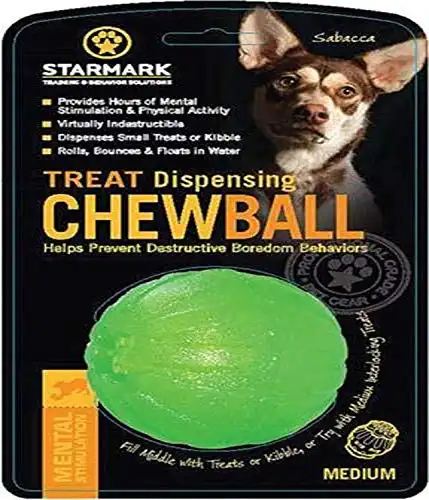
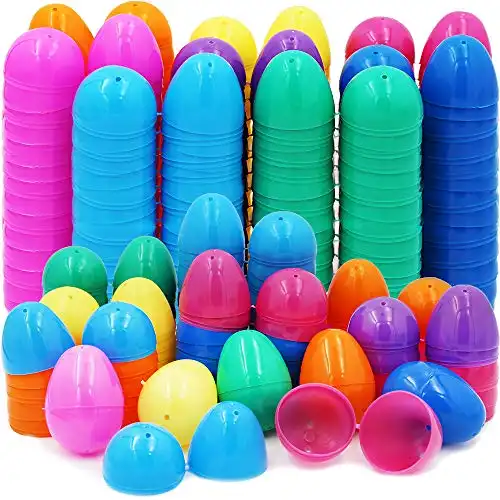

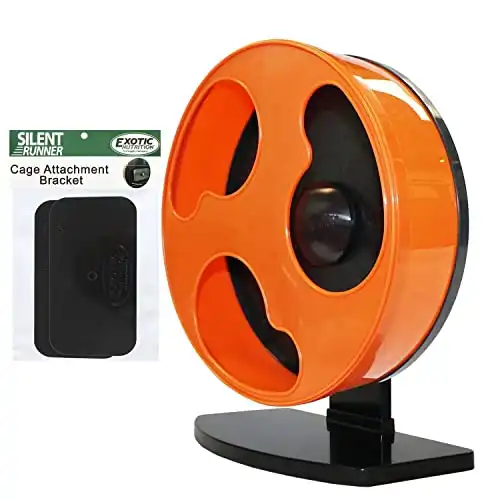
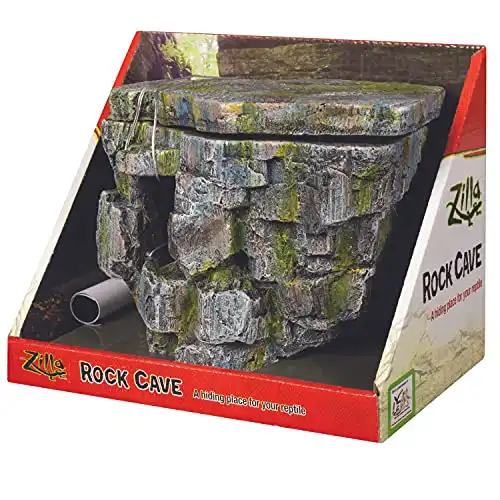
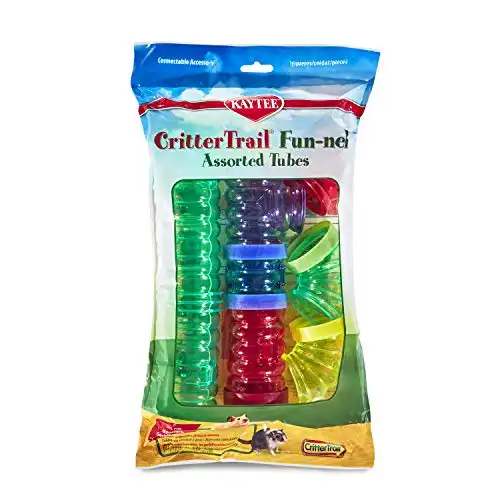
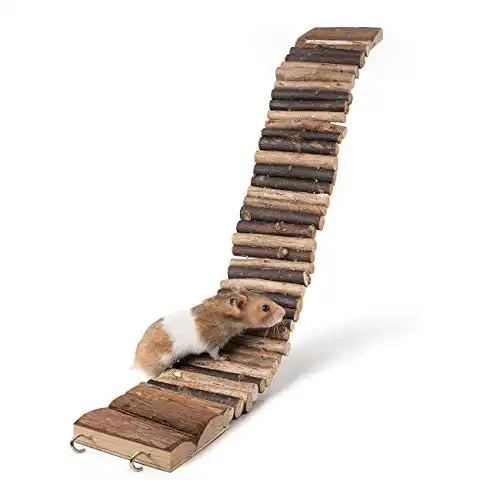
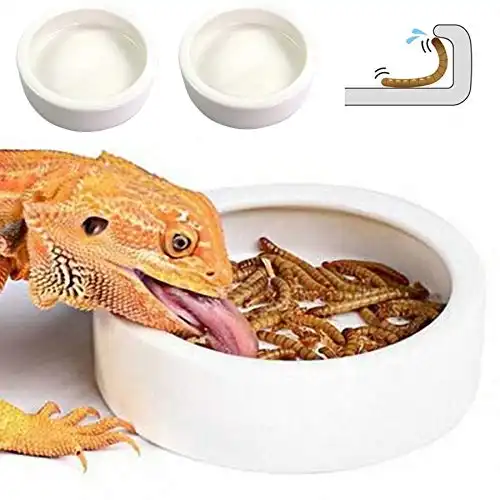

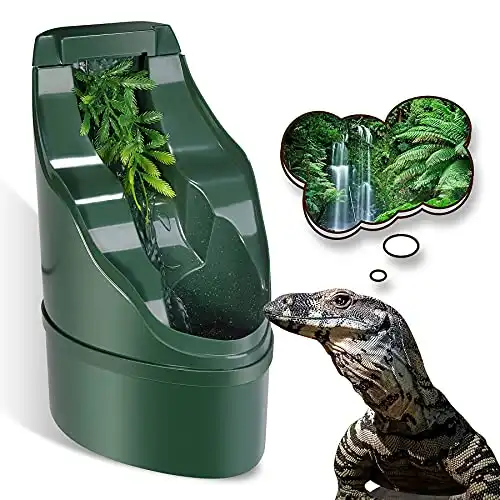

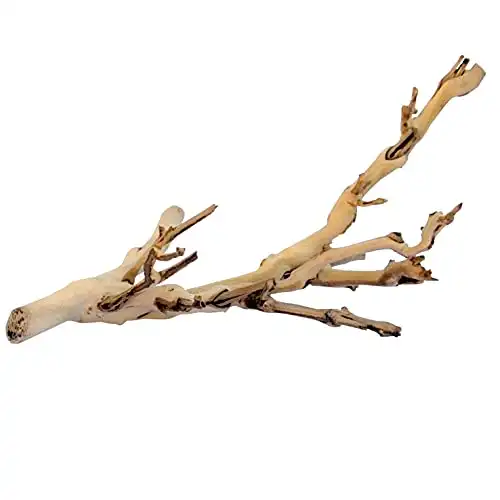
![Ceramic Heater vs Halogen For Leopard Gecko: Which is Best? [11 Factors]](https://www.reptilehero.com/wp-content/uploads/2021/08/che-halogen-comparison-gecko-small-cover-infographic.jpg)
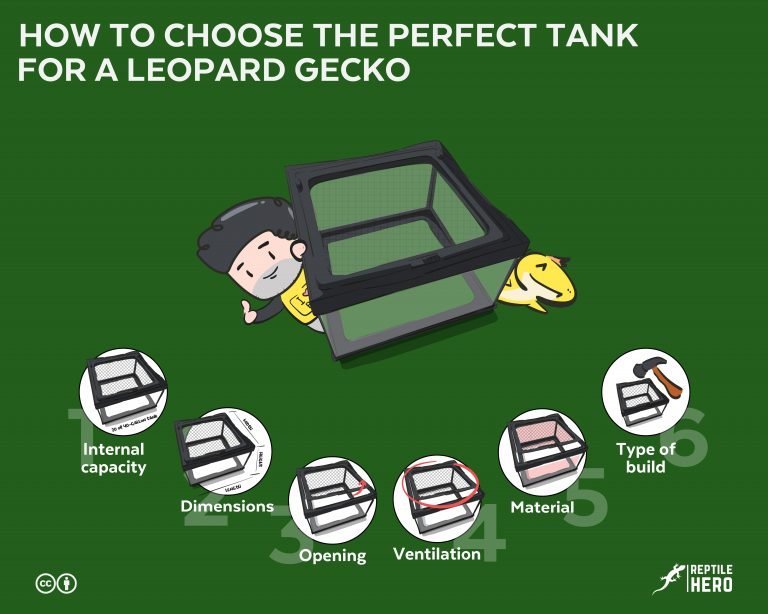

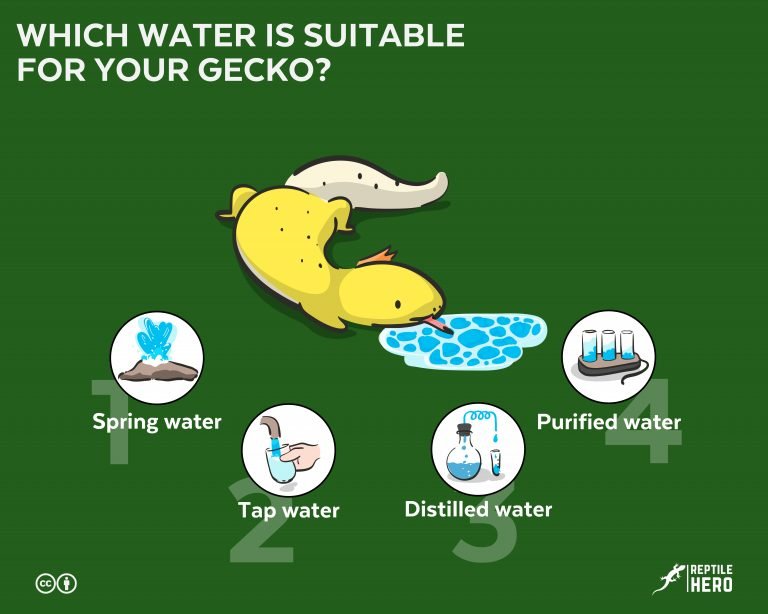

![3 Reasons Why Your Gecko Smells Bad [and 7 Tips]](https://www.reptilehero.com/wp-content/uploads/2021/04/G34_2-1-768x614.jpg)